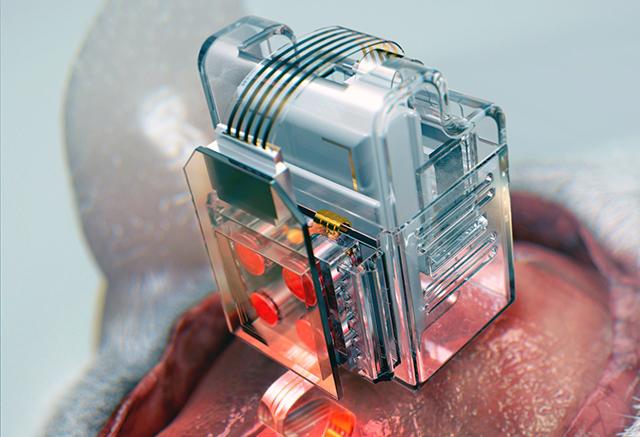
Scientists manipulate brain cells using a smartphone
A soft neural implant, capable of delivering multiple drugs and color lights, might speed research on diseases such as Parkinson’s, Alzheimer’s, addiction, depression and pain.Media Contact: Bobbi Nodell, bnodell@uw.edu, 206.543.7129

A team of scientists in South Korea and the United States have invented a device that can control neural circuits by using a tiny brain implant managedby a smartphone.
Publishing in Nature Biomedical Engineering, the researchers said the soft neural implant is the first wireless neural device capable of delivering multiple drugs and color lights. The device could speed up efforts to uncover brain diseases, such as Parkinson’s, Alzheimer’s, addiction, depression, and pain.
“The wireless neural device enables chronic chemical and optical neuromodulation that has never been achieved before,” said lead author Raza Qazi, a researcher with the Korea Advanced Institute of Science and Technology and University of Colorado Boulder.
Co-author Michael Bruchas, a professor of anesthesiology and pain medicine and pharmacology at the University of Washington School of Medicine, said this technology will help researchers in many ways.
“It allows us to better dissect the neural circuit basis of behavior, and how specific neuromodulators in the brain tune behavior in various ways,” he said. “We are also eager to use the device for complex pharmacological studies, which could help us develop new therapeutics for pain, addiction and emotional disorders.”
The device uses Lego-like replaceable drug cartridges and powerful bluetooth low-energy to deliver drugs and light to specific neurons of interest.
Resarchers said this technology significantly overshadows conventional neuroscience methods, which usually involve rigid metal tubes and optical fibers. Though some efforts have addressed adverse tissue response by incorporating soft probes and wireless platforms, the previous solutions were limited by their inability to deliver drugs for long periods of time as well as their bulky and complex control setups.
To achieve chronic wireless drug delivery, scientists had to solve the critical challenge of exhaustion and evaporation of drugs. The researchers collaborated to invent the neural device, which could allow neuroscientists to study the same brain circuits for several months without worrying about running out of drugs.
These "plug and play" drug cartridges were assembled into a brain implant for mice with a soft and ultrathin probe, the thickness of a human hair, which consisted of microfluidic channels and tiny LEDs, smaller than a grain of salt, for unlimited drug doses and light delivery.
Controlled with a simple user interface on a smartphone, the device can create a specific combination or precise sequencing of light and drug deliveries in any implanted target animal without need to be inside the laboratory. With this device, researchers could easily setup fully automated animal studies where behavior of one animal could positively or negatively affect behavior in other animals by conditional triggering of light and/or drug delivery.
“This revolutionary device is the fruit of advanced electronics design and powerful micro and nanoscale engineering,” said Jae-Woong Jeong, a professor of electrical engineering at KAIST. “We are interested in further developing this technology to make a brain implant for clinical applications.”
The researchers at the Jeong group at KAIST, South Korea, develop soft electronics for wearable and implantable devices. The neuroscientists at the Bruchas Lab in Seattle study brain circuits that control stress, depression, addiction, pain and other neuropsychiatric disorders. This collaborative effort among engineers and neuroscientists over three years and tens of design iterations led to the successful validation of this brain implant in freely moving mice.
This work was supported by grants from the National Research Foundation of Korea, the National Institutes of Health, National Institute on Drug Abuse, and Mallinckrodt Professorship.
For details about UW Medicine, please visit https://uwmedicine.org/about.